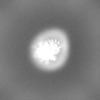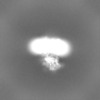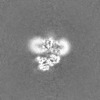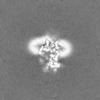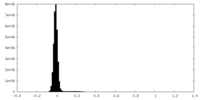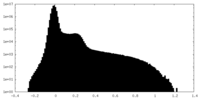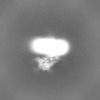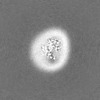[English] 日本語
 Yorodumi
Yorodumi- EMDB-37110: Cryo-EM structure of human gamma-secretase in complex with MK-0752 -
+ Open data
Open data
- Basic information
Basic information
| Entry | 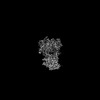 | |||||||||
|---|---|---|---|---|---|---|---|---|---|---|
| Title | Cryo-EM structure of human gamma-secretase in complex with MK-0752 | |||||||||
 Map data Map data | ||||||||||
 Sample Sample |
| |||||||||
 Keywords Keywords | Intramembrane protease / gamma-secretase / gamma-secretase inhibitor / MEMBRANE PROTEIN / MEMBRANE PROTEIN-HYDROLASE complex | |||||||||
| Function / homology |  Function and homology information Function and homology informationCajal-Retzius cell differentiation / positive regulation of L-glutamate import across plasma membrane / amyloid precursor protein biosynthetic process / negative regulation of core promoter binding / gamma-secretase complex / aspartic endopeptidase activity, intramembrane cleaving / short-term synaptic potentiation / positive regulation of endopeptidase activity / positive regulation of amyloid precursor protein biosynthetic process / Noncanonical activation of NOTCH3 ...Cajal-Retzius cell differentiation / positive regulation of L-glutamate import across plasma membrane / amyloid precursor protein biosynthetic process / negative regulation of core promoter binding / gamma-secretase complex / aspartic endopeptidase activity, intramembrane cleaving / short-term synaptic potentiation / positive regulation of endopeptidase activity / positive regulation of amyloid precursor protein biosynthetic process / Noncanonical activation of NOTCH3 / protein catabolic process at postsynapse / TGFBR3 PTM regulation / sequestering of calcium ion / Notch receptor processing / synaptic vesicle targeting / positive regulation of coagulation / negative regulation of axonogenesis / central nervous system myelination / membrane protein intracellular domain proteolysis / growth factor receptor binding / T cell activation involved in immune response / skin morphogenesis / choline transport / NOTCH4 Activation and Transmission of Signal to the Nucleus / dorsal/ventral neural tube patterning / neural retina development / regulation of resting membrane potential / myeloid dendritic cell differentiation / L-glutamate import across plasma membrane / Regulated proteolysis of p75NTR / regulation of phosphorylation / metanephros development / locomotion / brain morphogenesis / endoplasmic reticulum calcium ion homeostasis / nuclear outer membrane / amyloid precursor protein metabolic process / regulation of synaptic vesicle cycle / regulation of long-term synaptic potentiation / smooth endoplasmic reticulum calcium ion homeostasis / astrocyte activation involved in immune response / embryonic limb morphogenesis / regulation of postsynapse organization / regulation of canonical Wnt signaling pathway / cell fate specification / skeletal system morphogenesis / aggresome / myeloid cell homeostasis / azurophil granule membrane / G protein-coupled dopamine receptor signaling pathway / ciliary rootlet / Hydrolases; Acting on peptide bonds (peptidases); Aspartic endopeptidases / glutamate receptor signaling pathway / Golgi cisterna membrane / positive regulation of dendritic spine development / positive regulation of amyloid fibril formation / positive regulation of receptor recycling / regulation of neuron projection development / protein glycosylation / blood vessel development / mitochondrial transport / adult behavior / amyloid precursor protein catabolic process / heart looping / cerebral cortex cell migration / amyloid-beta formation / membrane protein ectodomain proteolysis / negative regulation of apoptotic signaling pathway / autophagosome assembly / EPH-ephrin mediated repulsion of cells / negative regulation of ubiquitin-dependent protein catabolic process / endopeptidase activator activity / neuron development / somitogenesis / smooth endoplasmic reticulum / hematopoietic progenitor cell differentiation / Nuclear signaling by ERBB4 / calcium ion homeostasis / T cell proliferation / regulation of synaptic transmission, glutamatergic / rough endoplasmic reticulum / Notch signaling pathway / Degradation of the extracellular matrix / neuron projection maintenance / NOTCH2 Activation and Transmission of Signal to the Nucleus / cerebellum development / cellular response to calcium ion / NRIF signals cell death from the nucleus / Activated NOTCH1 Transmits Signal to the Nucleus / dendritic shaft / thymus development / positive regulation of glycolytic process / post-embryonic development / epithelial cell proliferation / PDZ domain binding / astrocyte activation / NOTCH3 Activation and Transmission of Signal to the Nucleus / apoptotic signaling pathway / neuron migration / synapse organization Similarity search - Function | |||||||||
| Biological species |  Homo sapiens (human) Homo sapiens (human) | |||||||||
| Method | single particle reconstruction / cryo EM / Resolution: 2.7 Å | |||||||||
 Authors Authors | Guo X / Li H / Kai U / Yan C / Lei J / Zhou R / Shi Y | |||||||||
| Funding support |  China, 1 items China, 1 items
| |||||||||
 Citation Citation |  Journal: Nat Struct Mol Biol / Year: 2025 Journal: Nat Struct Mol Biol / Year: 2025Title: Structural basis of human γ-secretase inhibition by anticancer clinical compounds. Authors: Xuefei Guo / Haotian Li / Xiaoli Lu / Hao Liu / Kaicheng U / Chuangye Yan / Jianlin Lei / Jing Huang / Rui Zhou / Yigong Shi /   Abstract: Aberrant activation of Notch signaling, mediated by the Notch intracellular domain (NICD), is linked to certain types of cancer. The NICD is released through γ-secretase-mediated cleavage of the ...Aberrant activation of Notch signaling, mediated by the Notch intracellular domain (NICD), is linked to certain types of cancer. The NICD is released through γ-secretase-mediated cleavage of the Notch receptor. Therefore, development of a γ-secretase inhibitor (GSI) represents an anticancer strategy. Here we report the cryo-electron microscopy structures of human γ-secretase bound individually to five clinically tested GSIs (RO4929097, crenigacestat, BMS906024, nirogacestat and MK-0752) at overall resolutions of 2.4-3.0 Å. Three of the five GSIs are in active anticancer clinical trials, while nirogacestat was recently approved. Each of these GSIs similarly occupies the substrate-binding site of presenilin 1 but shows characteristic differences in detailed recognition pattern. The size and shape of the binding pocket are induced by the bound GSI. Analysis of these structural features suggest strategies for modification of the GSI with improved inhibition potency. | |||||||||
| History |
|
- Structure visualization
Structure visualization
| Supplemental images |
|---|
- Downloads & links
Downloads & links
-EMDB archive
| Map data |  emd_37110.map.gz emd_37110.map.gz | 118 MB |  EMDB map data format EMDB map data format | |
|---|---|---|---|---|
| Header (meta data) |  emd-37110-v30.xml emd-37110-v30.xml emd-37110.xml emd-37110.xml | 23.1 KB 23.1 KB | Display Display |  EMDB header EMDB header |
| Images |  emd_37110.png emd_37110.png | 140.7 KB | ||
| Filedesc metadata |  emd-37110.cif.gz emd-37110.cif.gz | 7.5 KB | ||
| Others |  emd_37110_half_map_1.map.gz emd_37110_half_map_1.map.gz emd_37110_half_map_2.map.gz emd_37110_half_map_2.map.gz | 115.9 MB 115.9 MB | ||
| Archive directory |  http://ftp.pdbj.org/pub/emdb/structures/EMD-37110 http://ftp.pdbj.org/pub/emdb/structures/EMD-37110 ftp://ftp.pdbj.org/pub/emdb/structures/EMD-37110 ftp://ftp.pdbj.org/pub/emdb/structures/EMD-37110 | HTTPS FTP |
-Validation report
| Summary document |  emd_37110_validation.pdf.gz emd_37110_validation.pdf.gz | 819.9 KB | Display |  EMDB validaton report EMDB validaton report |
|---|---|---|---|---|
| Full document |  emd_37110_full_validation.pdf.gz emd_37110_full_validation.pdf.gz | 819.6 KB | Display | |
| Data in XML |  emd_37110_validation.xml.gz emd_37110_validation.xml.gz | 14 KB | Display | |
| Data in CIF |  emd_37110_validation.cif.gz emd_37110_validation.cif.gz | 16.6 KB | Display | |
| Arichive directory |  https://ftp.pdbj.org/pub/emdb/validation_reports/EMD-37110 https://ftp.pdbj.org/pub/emdb/validation_reports/EMD-37110 ftp://ftp.pdbj.org/pub/emdb/validation_reports/EMD-37110 ftp://ftp.pdbj.org/pub/emdb/validation_reports/EMD-37110 | HTTPS FTP |
-Related structure data
| Related structure data | 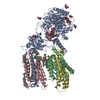 8kcuMC 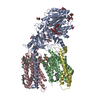 8kcoC 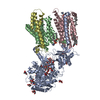 8kcpC  8kcsC 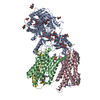 8kctC M: atomic model generated by this map C: citing same article ( |
|---|---|
| Similar structure data | Similarity search - Function & homology  F&H Search F&H Search |
- Links
Links
| EMDB pages |  EMDB (EBI/PDBe) / EMDB (EBI/PDBe) /  EMDataResource EMDataResource |
|---|---|
| Related items in Molecule of the Month |
- Map
Map
| File |  Download / File: emd_37110.map.gz / Format: CCP4 / Size: 125 MB / Type: IMAGE STORED AS FLOATING POINT NUMBER (4 BYTES) Download / File: emd_37110.map.gz / Format: CCP4 / Size: 125 MB / Type: IMAGE STORED AS FLOATING POINT NUMBER (4 BYTES) | ||||||||||||||||||||||||||||||||||||
|---|---|---|---|---|---|---|---|---|---|---|---|---|---|---|---|---|---|---|---|---|---|---|---|---|---|---|---|---|---|---|---|---|---|---|---|---|---|
| Projections & slices | Image control
Images are generated by Spider. | ||||||||||||||||||||||||||||||||||||
| Voxel size | X=Y=Z: 1.0825 Å | ||||||||||||||||||||||||||||||||||||
| Density |
| ||||||||||||||||||||||||||||||||||||
| Symmetry | Space group: 1 | ||||||||||||||||||||||||||||||||||||
| Details | EMDB XML:
|
-Supplemental data
-Half map: #2
| File | emd_37110_half_map_1.map | ||||||||||||
|---|---|---|---|---|---|---|---|---|---|---|---|---|---|
| Projections & Slices |
| ||||||||||||
| Density Histograms |
-Half map: #1
| File | emd_37110_half_map_2.map | ||||||||||||
|---|---|---|---|---|---|---|---|---|---|---|---|---|---|
| Projections & Slices |
| ||||||||||||
| Density Histograms |
- Sample components
Sample components
-Entire : Cryo-EM structure of human gamma-secretase in complex with MK-0752
| Entire | Name: Cryo-EM structure of human gamma-secretase in complex with MK-0752 |
|---|---|
| Components |
|
-Supramolecule #1: Cryo-EM structure of human gamma-secretase in complex with MK-0752
| Supramolecule | Name: Cryo-EM structure of human gamma-secretase in complex with MK-0752 type: complex / ID: 1 / Parent: 0 / Macromolecule list: #2, #1, #3-#4 |
|---|---|
| Source (natural) | Organism:  Homo sapiens (human) Homo sapiens (human) |
-Macromolecule #1: Presenilin-1
| Macromolecule | Name: Presenilin-1 / type: protein_or_peptide / ID: 1 / Number of copies: 1 / Enantiomer: LEVO EC number: Hydrolases; Acting on peptide bonds (peptidases); Aspartic endopeptidases |
|---|---|
| Source (natural) | Organism:  Homo sapiens (human) Homo sapiens (human) |
| Molecular weight | Theoretical: 52.713535 KDa |
| Recombinant expression | Organism:  Homo sapiens (human) Homo sapiens (human) |
| Sequence | String: MTELPAPLSY FQNAQMSEDN HLSNTVRSQN DNRERQEHND RRSLGHPEPL SNGRPQGNSR QVVEQDEEED EELTLKYGAK HVIMLFVPV TLCMVVVVAT IKSVSFYTRK DGQLIYTPFT EDTETVGQRA LHSILNAAIM ISVIVVMTIL LVVLYKYRCY K VIHAWLII ...String: MTELPAPLSY FQNAQMSEDN HLSNTVRSQN DNRERQEHND RRSLGHPEPL SNGRPQGNSR QVVEQDEEED EELTLKYGAK HVIMLFVPV TLCMVVVVAT IKSVSFYTRK DGQLIYTPFT EDTETVGQRA LHSILNAAIM ISVIVVMTIL LVVLYKYRCY K VIHAWLII SSLLLLFFFS FIYLGEVFKT YNVAVDYITV ALLIWNFGVV GMISIHWKGP LRLQQAYLIM ISALMALVFI KY LPEWTAW LILAVISVYD LVAVLCPKGP LRMLVETAQE RNETLFPALI YSSTMVWLVN MAEGDPEAQR RVSKNSKYNA EST ERESQD TVAENDDGGF SEEWEAQRDS HLGPHRSTPE SRAAVQELSS SILAGEDPEE RGVKLGLGDF IFYSVLVGKA SATA SGDWN TTIACFVAIL IGLCLTLLLL AIFKKALPAL PISITFGLVF YFATDYLVQP FMDQLAFHQF YI UniProtKB: Presenilin-1 |
-Macromolecule #2: Nicastrin
| Macromolecule | Name: Nicastrin / type: protein_or_peptide / ID: 2 / Number of copies: 1 / Enantiomer: LEVO |
|---|---|
| Source (natural) | Organism:  Homo sapiens (human) Homo sapiens (human) |
| Molecular weight | Theoretical: 77.622617 KDa |
| Recombinant expression | Organism:  Homo sapiens (human) Homo sapiens (human) |
| Sequence | String: MATAGGGSGA DPGSRGLLRL LSFCVLLAGL CRGNSVERKI YIPLNKTAPC VRLLNATHQI GCQSSISGDT GVIHVVEKEE DLQWVLTDG PNPPYMVLLE SKHFTRDLME KLKGRTSRIA GLAVSLTKPS PASGFSPSVQ CPNDGFGVYS NSYGPEFAHC R EIQWNSLG ...String: MATAGGGSGA DPGSRGLLRL LSFCVLLAGL CRGNSVERKI YIPLNKTAPC VRLLNATHQI GCQSSISGDT GVIHVVEKEE DLQWVLTDG PNPPYMVLLE SKHFTRDLME KLKGRTSRIA GLAVSLTKPS PASGFSPSVQ CPNDGFGVYS NSYGPEFAHC R EIQWNSLG NGLAYEDFSF PIFLLEDENE TKVIKQCYQD HNLSQNGSAP TFPLCAMQLF SHMHAVISTA TCMRRSSIQS TF SINPEIV CDPLSDYNVW SMLKPINTTG TLKPDDRVVV AATRLDSRSF FWNVAPGAES AVASFVTQLA AAEALQKAPD VTT LPRNVM FVFFQGETFD YIGSSRMVYD MEKGKFPVQL ENVDSFVELG QVALRTSLEL WMHTDPVSQK NESVRNQVED LLAT LEKSG AGVPAVILRR PNQSQPLPPS SLQRFLRARN ISGVVLADHS GAFHNKYYQS IYDTAENINV SYPEWLSPEE DLNFV TDTA KALADVATVL GRALYELAGG TNFSDTVQAD PQTVTRLLYG FLIKANNSWF QSILRQDLRS YLGDGPLQHY IAVSSP TNT TYVVQYALAN LTGTVVNLTR EQCQDPSKVP SENKDLYEYS WVQGPLHSNE TDRLPRCVRS TARLARALSP AFELSQW SS TEYSTWTESR WKDIRARIFL IASKELELIT LTVGFGILIF SLIVTYCINA KADVLFIAP UniProtKB: Nicastrin |
-Macromolecule #3: Gamma-secretase subunit APH-1A
| Macromolecule | Name: Gamma-secretase subunit APH-1A / type: protein_or_peptide / ID: 3 / Number of copies: 1 / Enantiomer: LEVO |
|---|---|
| Source (natural) | Organism:  Homo sapiens (human) Homo sapiens (human) |
| Molecular weight | Theoretical: 29.017943 KDa |
| Recombinant expression | Organism:  Homo sapiens (human) Homo sapiens (human) |
| Sequence | String: MGAAVFFGCT FVAFGPAFAL FLITVAGDPL RVIILVAGAF FWLVSLLLAS VVWFILVHVT DRSDARLQYG LLIFGAAVSV LLQEVFRFA YYKLLKKADE GLASLSEDGR SPISIRQMAY VSGLSFGIIS GVFSVINILA DALGPGVVGI HGDSPYYFLT S AFLTAAII ...String: MGAAVFFGCT FVAFGPAFAL FLITVAGDPL RVIILVAGAF FWLVSLLLAS VVWFILVHVT DRSDARLQYG LLIFGAAVSV LLQEVFRFA YYKLLKKADE GLASLSEDGR SPISIRQMAY VSGLSFGIIS GVFSVINILA DALGPGVVGI HGDSPYYFLT S AFLTAAII LLHTFWGVVF FDACERRRYW ALGLVVGSHL LTSGLTFLNP WYEASLLPIY AVTVSMGLWA FITAGGSLRS IQ RSLLCRR QEDSRVMVYS ALRIPPED UniProtKB: Gamma-secretase subunit APH-1A |
-Macromolecule #4: Gamma-secretase subunit PEN-2
| Macromolecule | Name: Gamma-secretase subunit PEN-2 / type: protein_or_peptide / ID: 4 / Number of copies: 1 / Enantiomer: LEVO |
|---|---|
| Source (natural) | Organism:  Homo sapiens (human) Homo sapiens (human) |
| Molecular weight | Theoretical: 12.038029 KDa |
| Recombinant expression | Organism:  Homo sapiens (human) Homo sapiens (human) |
| Sequence | String: MNLERVSNEE KLNLCRKYYL GGFAFLPFLW LVNIFWFFRE AFLVPAYTEQ SQIKGYVWRS AVGFLFWVIV LTSWITIFQI YRPRWGALG DYLSFTIPLG TP UniProtKB: Gamma-secretase subunit PEN-2 |
-Macromolecule #7: 1,2-DIACYL-SN-GLYCERO-3-PHOSPHOCHOLINE
| Macromolecule | Name: 1,2-DIACYL-SN-GLYCERO-3-PHOSPHOCHOLINE / type: ligand / ID: 7 / Number of copies: 2 / Formula: PC1 |
|---|---|
| Molecular weight | Theoretical: 790.145 Da |
| Chemical component information |  ChemComp-PC1: |
-Macromolecule #8: MK-0752
| Macromolecule | Name: MK-0752 / type: ligand / ID: 8 / Number of copies: 1 / Formula: OL9 |
|---|---|
| Molecular weight | Theoretical: 442.904 Da |
-Macromolecule #9: 2-acetamido-2-deoxy-beta-D-glucopyranose
| Macromolecule | Name: 2-acetamido-2-deoxy-beta-D-glucopyranose / type: ligand / ID: 9 / Number of copies: 6 / Formula: NAG |
|---|---|
| Molecular weight | Theoretical: 221.208 Da |
| Chemical component information | 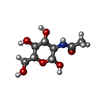 ChemComp-NAG: |
-Macromolecule #10: CHOLESTEROL
| Macromolecule | Name: CHOLESTEROL / type: ligand / ID: 10 / Number of copies: 3 / Formula: CLR |
|---|---|
| Molecular weight | Theoretical: 386.654 Da |
| Chemical component information |  ChemComp-CLR: |
-Experimental details
-Structure determination
| Method | cryo EM |
|---|---|
 Processing Processing | single particle reconstruction |
| Aggregation state | particle |
- Sample preparation
Sample preparation
| Buffer | pH: 7.4 |
|---|---|
| Vitrification | Cryogen name: ETHANE |
- Electron microscopy
Electron microscopy
| Microscope | FEI TITAN KRIOS |
|---|---|
| Image recording | Film or detector model: GATAN K3 (6k x 4k) / Average electron dose: 50.0 e/Å2 |
| Electron beam | Acceleration voltage: 300 kV / Electron source:  FIELD EMISSION GUN FIELD EMISSION GUN |
| Electron optics | Illumination mode: FLOOD BEAM / Imaging mode: BRIGHT FIELD / Nominal defocus max: 1.8 µm / Nominal defocus min: 1.5 µm |
| Experimental equipment |  Model: Titan Krios / Image courtesy: FEI Company |
- Image processing
Image processing
| Startup model | Type of model: EMDB MAP EMDB ID: |
|---|---|
| Final reconstruction | Resolution.type: BY AUTHOR / Resolution: 2.7 Å / Resolution method: FSC 0.143 CUT-OFF / Number images used: 5349632 |
| Initial angle assignment | Type: MAXIMUM LIKELIHOOD |
| Final angle assignment | Type: MAXIMUM LIKELIHOOD |
 Movie
Movie Controller
Controller




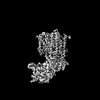



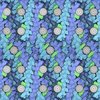


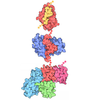
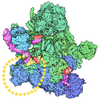



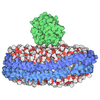

 Z (Sec.)
Z (Sec.) Y (Row.)
Y (Row.) X (Col.)
X (Col.)




















